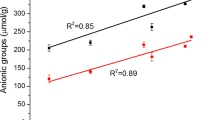Abstract
The consecutive pre-treatment of cellulose with periodate and bisulfite was used as a new potential method to promote nanofibrillation of hardwood pulp and to obtain nanofibrils with sulfonated functionality. Nanofibrils having typical widths of 10–60 nm were obtained from sulfonated celluloses having low anionic charge densities (0.18–0.51 mmol/g) by direct high-pressure homogenization without the use of any mechanical pre-treatments. The aqueous nanofibrils existed as highly viscous and transparent gels and possessed cellulose I crystalline structures with crystallinity indexes of approximately 40 %. A transparent film was obtained from sulfonated nanofibrils having tensile strength of 164 ± 4 MPa and Young’s modulus of 13.5 ± 0.4 MPa. Oxidative sulfonation was shown to be a potential green method to promote nanofibrillation of cellulose, as it avoids the production of halogenated wastes, because the periodate used can be efficiently regenerated and recycled as shown in the preliminary experiments.







Similar content being viewed by others
References
Abe K, Iwamoto S, Yano H (2007) Obtaining cellulose nanofibers with a uniform width of 15 nm from wood. Biomacromolecules 8:3276–3278
Besbes I, Alila S, Boufi S (2011) Nanofibrillated cellulose from TEMPO-oxidized eucalyptus fibres: effect of the carboxyl content. Carbohydr Polym 84:975–983
Bledzki AK, Reihmane S, Gassan JJ (1996) Properties and modification methods for vegetable fibers for natural fiber composites. J Appl Polym Sci 59:1329–1336
Calvini P, Conio G, Lorenzoni M, Pedemonte E (2004) Viscometric determination of dialdehyde content in periodate oxycellulose. Part I. Methodology. Cellulose 11:99–107
Chakraborty A, Sain M, Kortschot M (2006) Reinforcing potential of wood pulp-derived microfibres in a PVA matrix. Holzforschung 60:53–58
Fahlén J, Salmén L (2005) Pore and matrix distribution in the fiber wall revealed by atomic force microscopy and image analysis. Biomacromolecules 6:433–438
Hearon WM, Witte JF, Lo CF (1978) Process for the production of dialdehyde cellulose from cellulose. US Patent 4,082,743
Henriksson M, Berglund LA, Isaksson P, Lindström T, Nishino T (2008) Cellulose nanopaper structures of high toughness. Biomacromolecules 9:1579–1585
Herrick FW, Casebier RL, Hamilton JK, Sandberg KR (1983) Microfibrillated cellulose: morphology and accessibility. J Appl Polym Sci Appl Polym Symp 37:815–827
Katz S, Beatson RP, Scallan AM (1984) The determination of strong and weak acidic groups in sulphite pulps. Svensk Papperstidn 65:795–816
Lasseuguette E, Roux D, Nishiyama Y (2008) Rheological properties of microfibrillar suspension of TEMPO-oxidized pulp. Cellulose 15:425–433
Liimatainen H, Haapala A, Tomperi J, Niinimäki J (2009a) Fibre floc morphology and dewaterability of a pulp suspension: role of flocculation kinetics and characteristics of flocculation agents. BioResources 4:640–658
Liimatainen H, Haavisto S, Haapala A, Niinimäki J (2009b) Influence of adsorbed and soluble carboxymethyl cellulose on fibre suspension dispersing, dewaterability and fines retention. BioResources 4:321–340
Liimatainen H, Sirviö J, Haapala A, Hormi O, Niinimäki J (2011) Characterization of highly accessible cellulose microfibers generated by wet stirred media milling. Carbohydr Polym 83:2005–2010
Liimatainen H, Visanko M, Sirviö J, Hormi O, Niinimäki J (2012a) Enhancement of the nanofibrillation of wood cellulose through sequential periodate–chlorite oxidation. Biomacromolecules 13:1592–1597
Liimatainen H, Sirviö J, Sundman O, Hormi O, Niinimäki J (2012b) Use of nanoparticular and soluble anionic celluloses in coagulation–flocculation treatment of kaolin suspension. Water Res 1:2156–2166
Liu A, Walther A, Ikkala O, Belova L, Berglund LA (2011) Clay nanopaper with tough cellulose nanofiber matrix for fire retardancy and gas barrier functions. Biomacromolecules 12:633–641
Maekawa E, Koshijima TJ (1984) Properties of 2,3-dicarboxyl cellulose combined with various metal ions. J Appl Polym Sci 29:2289–2297
Mishra SP, Manent AS, Chabot B, Daneault CJ (2012) Production of nanocellulose from native cellulose—various options utilizing ultrasound. Wood Chem Technol 32:137–148
Nakagaito AN, Yano H (2004) The effect of morphological changes from pulp fiber towards nano-scale fibrillated cellulose on the mechanical properties of high-strength plant fiber based composites. Appl Phys A 78:547–552
Nikiforova TE, Kozlov VA, Russ J (2011) Sorption of copper (II) cations from aqueous media by a cellulose-containing sorbent. Gen Chem 81:2136–2141
Pääkkö M, Ankerfors M, Kosonen H, Nykänen A, Ahola S, Österberg MJ, Ruokolainen J, Laine J, Larsson PT, Ikkala O, Lindström T (2007) Enzymatic hydrolysis combined with mechanical shearing and high-pressure homogenization for nanoscale cellulose fibrils and strong gels. Biomacromolecules 8:1934–1941
Rattaz A, Mishra SP, Chabot B, Daneault C (2011) Cellulose nanofibres by sonocatalysed-TEMPO-oxidation. Cellulose 18:585–593
Saito T, Nishiyama Y, Putaux JL, Vignon M, Isogai A (2006) Homogeneous suspensions of individualized microfibrils from TEMPO-catalyzed oxidation of native cellulose. Biomacromolecules 7:1687–1691
Saito T, Kimura S, Nishiyama Y, Isogai A (2007) Cellulose nanofibers prepared by TEMPO-mediated oxidation of native cellulose. Biomacromolecules 8:2485–2491
Saito T, Hirota M, Tamura N, Kimura S, Fukuzumi H, Heux L, Isogai A (2009) Individualization of nano-sized plant cellulose fibrils by direct surface carboxylation using TEMPO catalyst under neutral conditions. Biomacromolecules 10:1992–1996
Segal L, Creely JJ, Martin AE Jr, Conrad CM (1959) An X-ray diffraction study of the conformation cellulose chain. Text Res J 29:786–794
Shet RT, Wallajabet PRR (1997) Sulfonated cellulose having improved absorbent properties. US Patent 5,703,225
Sirviö J, Hyväkkö U, Liimatainen H, Niinimäki J, Hormi O (2011) Periodate oxidation of cellulose at elevated temperatures using metal salts as cellulose activators. Carbohydr Polym 83:1293–1297
Zhang J, Jiang N, Dang Z, Elder TJ, Ragauskas AJ (2008) Oxidation and sulfonation of cellulosics. Cellulose 15:489–496
Acknowledgments
This work was financed by The Academy of Finland (Postdoctoral project No. 250940). The Wallenberg Wood Science Center, KTH, Sweden is acknowledged for the opportunity to use the mechanical tester.
Author information
Authors and Affiliations
Corresponding author
Rights and permissions
About this article
Cite this article
Liimatainen, H., Visanko, M., Sirviö, J. et al. Sulfonated cellulose nanofibrils obtained from wood pulp through regioselective oxidative bisulfite pre-treatment. Cellulose 20, 741–749 (2013). https://doi.org/10.1007/s10570-013-9865-y
Received:
Accepted:
Published:
Issue Date:
DOI: https://doi.org/10.1007/s10570-013-9865-y




